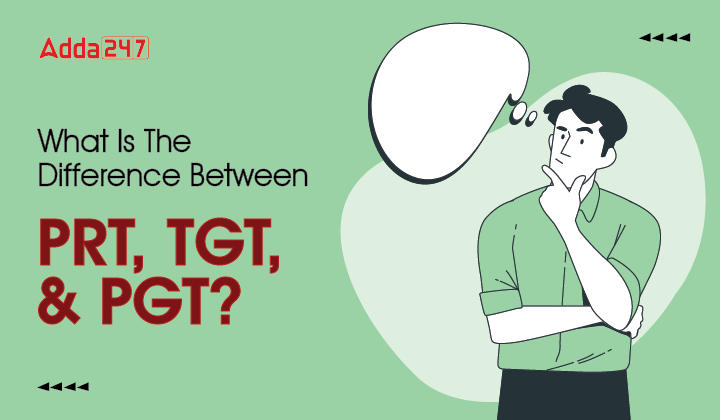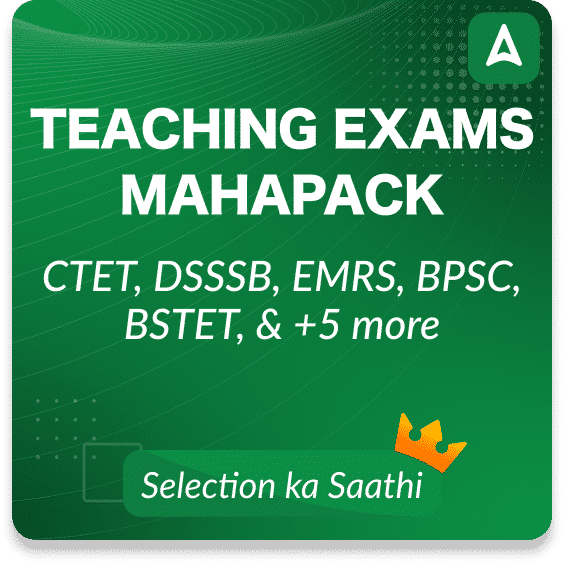Table of Contents
TET (Teacher Eligibility Test) is a teaching eligibility exam that has been conducted to test the capability of the students who want to teach Classes I to VIII. The TET exam is the eligibility criteria for applying to the Govt. and Private Teaching Jobs. The teaching profession is considered to be the noblest of all professions. The teaching profession comes with discipline, calibre, and passion which make the future of the child. The teaching profession in schools is divided into 3 levels i.e. PRT (Classes I to V), TGT (Classes I to VIII), and PGT (Classes IX to XII).
Difference Between PRT, TGT, And PGT
Teaching is the most popular career choice among job-seekers in India. However, to become a teacher at the pre-nursery, nursery, primary, secondary, and senior secondary levels in schools, the aspirants need to possess the right qualifications. PRT, TGT, and PGT refer to the teaching titles of school teachers. PRT (Primary Teacher), TGT (Trained Graduate Teacher), and PGT (Post Graduate teacher) are the designations and not qualifications of teaching posts.
| Designation | Full Form | Level of Class |
|---|---|---|
| PRT | Primary Teacher | 1st – 5th |
| TGT | Trained Graduate Teacher | 6th – 8th |
| PGT | Post Graduate Teacher | 9th – 12th |
PRT, TGT, and PGT Teacher Highlights
PRT, TGT & PGT Teachers are the main profiles in all the schools. Primary Teacher taught 1st to 5th Std. classes, Trained Graduate Teacher taught 6th to 10th Std & Post Graduate Teacher taught 11th & 12th class.
| Teaching Posts | PRT, TGT, PGT |
| PRT Full Form | Primary Teacher |
| TGT Full Form | Trained Graduate Teacher |
| PGT Full Form | Post Graduate Teacher |
What is Difference Between PRT, TGT & PGT?
Check out the following table for a detailed understanding of the basic difference between PRT, TGT & PGT posts. The candidates who wish to become a teachers in India in Government Schools must have a clear idea of the segregation of Teaching Levels and educational requirements as mentioned below.
| Difference between PRT, TGT & PGT | |||
| Criteria | PRT | TGT | PGT |
| Full Form | Primary Teacher | Trained Graduate Teacher | Post Graduate Teacher |
| Teaching Level | Classes 1 to 5 | Classes 6 to 8 | Classes 9 to 12 |
| Educational Qualification | Diploma in Elementary Education (D.El.Ed) + CTET Paper I | Bachelor’s degree in education or related field + Bachelor’s degree in Education + B.Ed + CTET Paper II | Post Graduate degree + B.Ed |
| Entrance Exam Requirement | D.El.Ed Entrance Exam | B.Ed Entrance Exam | B.Ed Entrance Exam |
| Subjects Taught | General subjects | Mathematics, Science, Social Studies, Languages, etc. | Specialized subjects and General subjects |
| Responsibilities | Teaching basic concepts, preparing lesson plans, assessing student performance | Providing deeper understanding, preparing students for higher education, extracurricular activities | Teaching advanced concepts, preparing students for board exams, extracurricular activities |
Who is a Primary Teacher (PRT)?
The Full Form of PRT is Primary Teacher. A primary teacher or an Elementary Teacher teaches students at the Primary level, i.e., classes 1 to 5. To become a Primary Teacher, a candidate must possess a Diploma in Elementary Education (D.El.Ed). This is a 2-year diploma course that can be pursued via full-time classroom training as well as distance learning. This diploma generally comprises four semesters and prepares a candidate to work as a teacher in primary schools.
Many Government and Private Institutions across the country provide a Diploma in Elementary Education. The admission to D.El.Ed is awarded through an entrance examination which requires a candidate to have passed 10+2 or equivalent with at least 50 percent marks in aggregate.
Who is a Trained Graduate Teacher (TGT)?
TGT Full form is Trained Graduate Teacher. TGTs are eligible to teach classes 6 to 10. To become a Trained Graduate Teacher, one has to pass the B. Ed which is also a two years professional course and TET qualified. TGTs are responsible for providing a deeper understanding of subjects and preparing students for higher education. They teach subjects such as mathematics, science, social studies, languages, and other specialized subjects.
TGTs are required to have a Bachelor’s degree in education or a related field, along with a Bachelor’s degree in Education. They are trained to develop lesson plans, teach the subject matter effectively, assess student performance, and provide feedback to help students improve. TGTs may also be responsible for extracurricular activities, such as coaching sports teams or advising student clubs.
Who is a Post Graduate Teacher (PGT)?
PGT Full Form Is Post Graduate Teacher. The Post Graduate Teacher teaches classes up to 12th standard. The difference between a TGT and a PGT is that a TGT does his/her B. Ed after graduation whereas to be a PGT, the candidate must possess a Post Graduate Degree before or after applying for a B. Ed course. Thus, with the same B. Ed degree, a graduate candidate is termed as TGT and a Post Graduate Candidate is termed as PGT.
To become a PGT, an aspirant must possess any of the following qualifications from any recognized University or Institution before admission to the B. Ed course:
- M. Tech in any stream
- Engineering Degree in any stream + Post Graduate Diploma
- Master of Science
- Master of Arts
- Master of Commerce
- Master of Computer Application
- Any other Master’s degree
Once a candidate has completed the prerequisites for becoming a PRT, TGT, and PGT, he/she can apply for a number of teaching eligibility examinations conducted annually. These examinations form the basis of the appointment of a candidate as a Primary and Upper Primary level teacher. A few authorized bodies that conduct recruitment examinations for teaching personnel are:
- Central Board of Secondary Education (CBSE): CTET
- Kendriya Vidyalaya Sangathan (KVS)
- Navodaya Vidyalaya Samiti (NVS)
- Delhi Subordinate Services Selection Board (DSSSB)
Teaching Objectives for PRT, TGT & PGT Posts
The objective of the Teaching post has been discussed below.
- To prepare the candidates to be able to understand and address the diversity in their profession. Because they will have to meet the intellectual demands of young pupils hailing from different socio-economic backgrounds with different upbringings, religions, cultures, ethnicities, etc.
- To enable and empower the candidate such that he/she can prepare a quality learning environment in their classroom.
- To familiarize the candidate with the proper and appropriate teaching processes.
- To develop leadership qualities and problem-solving skills among the candidates.
- To train the prospective teachers, so that they may be able to pass on the specific talents and skills required to enhance the knowledge of their students.
- To sensitize the candidates such that they follow an ethical and impartial attitude and contribute towards safeguarding the rights of children.



 What is Research Associate? Check Job Pr...
What is Research Associate? Check Job Pr...
 Difference between Research Associate an...
Difference between Research Associate an...
 KAR TET Application Form 2024, Apply Lin...
KAR TET Application Form 2024, Apply Lin...








